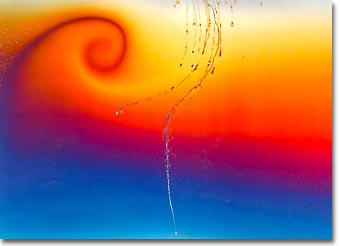Karl E. Deckart
Soap Bubble Gallery: Image Four
German photographer and artist Karl E. Deckart is known for his thorough, precise, and beautiful work both in photography through the microscope and with macro camera systems. This gallery of interference photographs made with soap films is a testament to both Deckart's skill as a photographer and his understanding of the physical phenomena that surround our everyday lives. Presented below is soap bubble image number four in small format. Click on the image to download a larger version.

|
Macrophotography of thin soap films freely suspended on a 4 x 4-inch wire frame was conducted with a Linhof large-format bellows camera system utilizing 4 x 5-inch sheet film and imaged using an apo-macro Nikon large format Nikkor-AM ED 210 mm f-5.6 lens. To prepare the soap film, equal parts of water, glycerin, and dishwasher detergent are thoroughly mixed in a container until a solution containing evenly sized micelles is achieved. A freestanding film is formed by dipping the wire frame into the solution and withdrawing carefully to maintain an even film thickness and avoid disruption of material flow across the frame rails. After suspension, the film was illuminated by a reflected light source positioned a few degrees from the camera system. The light was passed through a diffusion screen to avoid bright spots and provide an even illumination across the field. No polarizers were employed in photomacrography of soap thin films. Image ©1999 by Karl E. Deckart. All rights reserved. |
The production of soap includes a process termed saponification, with the word sapo being derived from the Latin meaning for "soap." When oil is boiled with an alkali, hydrolysis splits lipid molecules into glycerol and fatty acid components, which then combine with ionic sodium to produce soap. Early soap formulations relied on oils termed thallows, the hard fats obtained from byproducts of cattle, sheep, and other animals. During the fourteenth century, the French introduced olive oil as a main ingredient for soaps. Other oils used in soap making include coconut, palm, soybean, corn, and fish oils, each of which produces a different reaction during the wetting process. Coconut oils lather best in salty water, whereas thallows must be mixed with other oils to produce a satisfactory lather. Saponificating highly saturated fats with sodium hydroxide is employed to produce hard soaps. Oils having less saturation such as linseed, cottonseed, and fish are saponificated with potassium hydroxide to produce semi fluid and soft soaps.
BACK TO THE SOAP BUBBLE GALLERY
